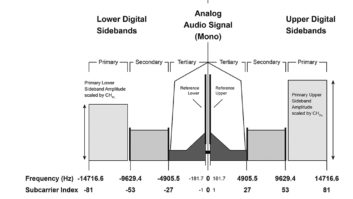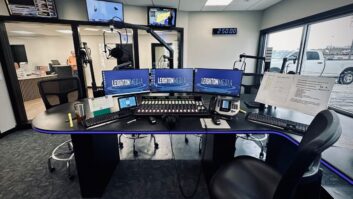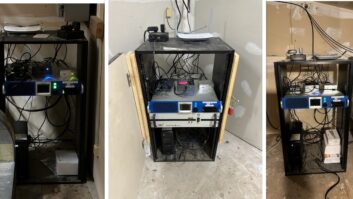If you think about it, an FM exciter is a transmitter. All it needs is a power amplifier to get RF to a desired level. That makes the exciter a vital link in the broadcast chain. An exciter is a bit complex in how an RF carrier is created and how audio impressed on it, but it’s not rocket science.
I see exciters in the shop that suffer various ills, almost all of them taking a station off the air. Here’s a grab bag of mods and repairs that may help you in future.

A Harris MX-15 exciter is shown on the testing bench.
One of the modifications I like to make to exciters is to add a power control on the front panel. I’ve had enough of poking a jeweler’s screwdriver through a hole in the top of an exciter to make an adjustment. Many transmitter tune-ups involve tweaking exciter power to get things just right. A control with a knob makes that job so much easier.
I also like to add a screwdriver-adjustable composite input level control on the rear so modulation can be adjusted easily.
The Harris THE-1 FM exciter has an output RF amplifier that can fail. Repairing it could be an expensive job, because the original manufacturer of the RF transistors is out of business. There appears to be no substitute for them. Harris has just a few complete working amplifier modules on hand at $2,128 each. Ouch! The exciter isn’t worth that when operational. I was faced with this dilemma recently and discovered an answer. It is the FM70 pallet amplifier for about $150 from Broadcast Concepts in Miami.

Power control knob as added to MX-15 exciter (click thumbnail)
Original PA module in THE-1 exciter

By cutting away part of the existing amplifier circuit card carefully and bolting this replacement amplifier in place, I was able to revive two THE-1 exciters. Wiring has to be reworked too. The existing RF output low-pass filter was probably responsible for the transistor failure in the first place. With an exciter terminated into a dummy load, a return loss measurement at the input to the filter showed about 8 dB, when it should have been at least 20 dB. Retuning the filter was the fix.

Revised THE-1 module being tested with return loss bridge
In the end, the exciter did not put out its rated 55 watts but topped out at 30 to 40 watts depending on which end of the FM band it was on. There wasn’t enough gain in the design to get full power. Most stations don’t need that kind of power anyway. Ten watts is pretty standard especially for tube transmitters.
Protection
Speaking of tubes, any solid-state exciter that feeds the tube input stage on a transmitter needs to be protected by a shorted quarter-wave stub. An arc-over in that tube could put 1,000 volts on the output transistor of an exciter, causing an immediate failure. Continental Electronics has recommended these devices highly for years.
You can build one by shorting a piece of coaxial cable at one-quarter wavelength from a “T” adapter on the output of the exciter or input to the transmitter. The difficult part is getting the length right so the exciter sees no VSWR when the stub is in the circuit. I do that in the shop by using a spectrum analyzer with tracking generator and a return loss bridge. It’s amazing how the right test equipment makes almost any job easy.

DIP switches accessed through new hole in cover
Many exciters are kept in standby status so they can be put on any frequency at a moment’s notice to substitute for a failed exciter. Almost every exciter that comes into the shop here gets a new set of DIP switches for frequency selection. That means putting switches in place of wire jumpers or replacing existing switches, which may fail after 20 years of service.
In the case of a Harris MS-15 or MX-15, I cut a rectangular hole in the AFC module cover so the switch positions can be changed easily without taking the cover off. Caution: Anyone setting up an exciter with switches needs to put it into a dummy load and frequency counter on a sample port before attempting to put it in service. There is always a chance that the switches may be set incorrectly and the exciter is playing merrily on the wrong frequency. I’ve seen that before, and the transmitter doesn’t tune with beans.
Many exciters show up in the shop here with the complaint that the station is being heard on three or more spots on the FM dial. Management likes the idea, the FCC doesn’t.

MX-15 PA module with replacement capacitors
The problem usually is a dried-out electrolytic bypass capacitor or two in the RF power amplifier stage of the exciter although I have seen it happen in the modulated oscillator section and power supply. Basically any oscillation, typically in the 100 kHz to 1.5 MHz range, will modulate the exciter’s signal to appear above and below the assigned frequency by that amount. Keeping the spectrum clean is an ongoing job for broadcast engineers.
Findmore Tech Tips under the News & Technology tab at radioworld.com.
Mark Persons WØMH is certified by the Society of Broadcast Engineers as a Professional Broadcast Engineer and has more than 30 years experience. His website is www.mwpersons.com.












